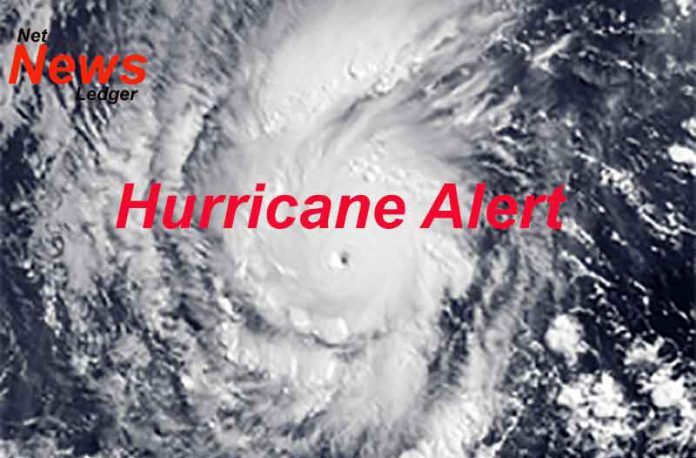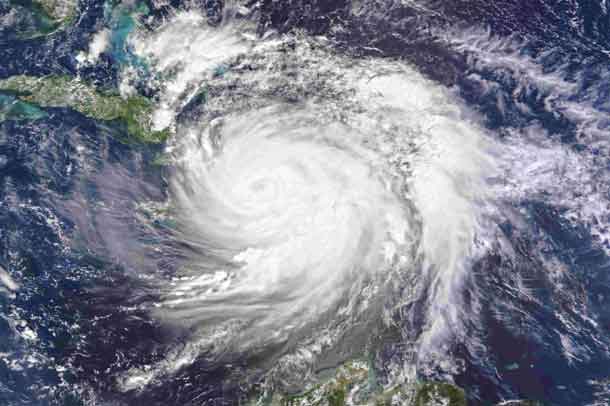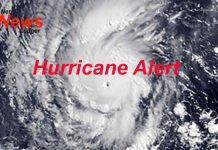Hurricane Dorian Intermediate Advisory Number 36A...Corrected NWS National Hurricane Center Miami FL AL052019 800 AM EDT Mon Sep 022019 Corrected rainfall statement ...EYE OF CATEGORY 5 DORIAN MOVING LITTLE WHILE OVER GRAND BAHAMA ISLAND... SUMMARY OF 800 AM EDT...1200 UTC...INFORMATION ---------------------------------------------- LOCATION...26.7N 78.2W ABOUT 35 MI...50 KM ENE OF FREEPORT GRAND BAHAMA ISLAND ABOUT 120 MI...190 KM E OF WEST PALM BEACH FLORIDA MAXIMUM SUSTAINED WINDS...165 MPH...270 KM/H PRESENT MOVEMENT...W OR 270 DEGREES AT 1 MPH...2 KM/H MINIMUM CENTRAL PRESSURE...916 MB...27.05 INCHES WATCHES AND WARNINGS -------------------- CHANGES WITH THIS ADVISORY: None SUMMARY OF WATCHES AND WARNINGS IN EFFECT: A Storm Surge Warning is in effect for... * Lantana to the Volusia/Brevard County Line A Storm Surge Watch is in effect for... * North of Deerfield Beach to south of Lantana * Volusia/Brevard County Line to the Mouth of the St. Mary's River A Hurricane Warning is in effect for... * Grand Bahama and the Abacos Islands in the northwestern Bahamas * Jupiter Inlet to the Volusia/Brevard County Line A Hurricane Watch is in effect for... * North of Deerfield Beach to Jupiter Inlet * Volusia/Brevard County Line to the Mouth of the St. Mary's River A Tropical Storm Warning is in effect for... * North of Deerfield Beach to Jupiter Inlet A Tropical Storm Watch is in effect for... * North of Golden Beach to Deerfield Beach * Lake Okeechobee A Storm Surge Warning means there is a danger of life-threatening inundation, from rising water moving inland from the coastline, during the next 36 hours in the indicated locations. For a depiction of areas at risk, please see the National Weather Service Storm Surge Watch/Warning Graphic, available at hurricanes.gov. This is a life-threatening situation. Persons located within these areas should take all necessary actions to protect life and property from rising water and the potential for other dangerous conditions. Promptly follow evacuation and other instructions from local officials. A Storm Surge Watch means there is a possibility of life- threatening inundation, from rising water moving inland from the coastline, in the indicated locations during the next 48 hours. A Hurricane Warning means that hurricane conditions are expected somewhere within the warning area. Preparations to protect life and property should be rushed to completion. A Hurricane Watch means that hurricane conditions are possible within the watch area. A watch is typically issued 48 hours before the anticipated first occurrence of tropical-storm-force winds, conditions that make outside preparations difficult or dangerous. A Tropical Storm Warning means that tropical storm conditions are expected within the warning area within 36 hours. A Tropical Storm Watch means that tropical storm conditions are possible within the watch area, generally within 48 hours. Interests elsewhere along southeast coast of the United States should continue to monitor the progress of Dorian, as additional watches may be required later today. For storm information specific to your area in the United States, including possible inland watches and warnings, please monitor products issued by your local National Weather Service forecast office. For storm information specific to your area outside of the United States, please monitor products issued by your national meteorological service. DISCUSSION AND OUTLOOK ---------------------- At 800 AM EDT (1200 UTC), the eye of Hurricane Dorian was located by NOAA Doppler radar near latitude 26.7 North, longitude 78.2 West. Dorian is moving toward the west near 1 mph (2 km/h). A slow westward to west-northwestward motion is forecast during the next day or so, followed by a gradual turn toward the northwest and north. On this track, the core of extremely dangerous Hurricane Dorian will continue to pound Grand Bahama Island through much of today and tonight. The hurricane will move dangerously close to the Florida east coast tonight through Wednesday evening. Maximum sustained winds are near 165 mph (270 km/h) with higher gusts. Dorian is a category 5 hurricane on the Saffir-Simpson Hurricane Wind Scale. Although gradual weakening is forecast, Dorian is expected to remain a powerful hurricane during the next couple of days. Hurricane-force winds extend outward up to 45 miles (75 km) from the center, and tropical-storm-force winds extend outward up to 140 miles (220 km). The estimated minimum central pressure is 916 mb (27.05 inches). HAZARDS AFFECTING LAND ---------------------- WIND: Catastrophic hurricane conditions continue on Grand Bahama Island. Do not venture out into the eye, as winds will suddenly increase after the eye passes. Hurricane conditions are expected within the Hurricane Warning area in Florida by late tonight or Tuesday. Hurricane conditions are possible in the Hurricane Watch area on Wednesday. Tropical storm conditions are expected within the Tropical Storm warning area today and Tuesday, and are possible in the Tropical Storm watch area by tonight. STORM SURGE: A life-threatening storm surge will raise water levels by as much as 18 to 23 feet above normal tide levels in areas of onshore winds on Grand Bahama Island. Near the coast, the surge will be accompanied by large and destructive waves. Water levels should very slowly subside on the Abaco Islands during the day. The combination of a dangerous storm surge and the tide will cause normally dry areas near the coast to be flooded by rising waters moving inland from the shoreline. The water could reach the following heights above ground somewhere in the indicated areas if the peak surge occurs at the time of high tide... Lantana to the Mouth of the St. Mary's River...4 to 7 ft North of Deerfield Beach to Lantana...2 to 4 ft The surge will be accompanied by large and destructive waves. Surge-related flooding depends on the how close the center of Dorian comes to the Florida east coast, and can vary greatly over short distances. For information specific to your area, please see products issued by your local National Weather Service forecast office. RAINFALL: Dorian is expected to produce the following rainfall totals through late this week: Northwestern Bahamas...12 to 24 inches, isolated 30 inches. Central Bahamas...Additional 1 to 3 inches, isolated storm totals of 6 inches. Coastal Carolinas...5 to 10 inches, isolated 15 inches. Atlantic Coast from the Florida peninsula through Georgia...4 to 8 inches, isolated 10 inches. This rainfall may cause life-threatening flash floods. SURF: Large swells are affecting east-facing shores of the Bahamas and the Florida east coast, and will spread northward along the southeastern United States coast during the next few days. These swells are likely to cause life-threatening surf and rip current conditions. Please consult products from your local weather office. TORNADOES: Isolated tornadoes are possible this afternoon into tonight along the immediate coast of east-central Florida. NEXT ADVISORY ------------- Next complete advisory at 1100 AM EDT.
September 01, 2019 – Update #3 – 3:00 pm – Devastating Category 5 Hurricane Dorian Makes a Direct Hit on Abacos Islands
The eye of Category 5 Hurricane Dorian was directly over the Abacos Islands as of the National Hurricane Center’s (NHC) 2:00 pm EDT advisory and is now heading towards Grand Bahama Island. The hurricane is located about 185 miles (295 km) east of West Palm Beach, FL. Maximum sustained winds are 185 mph (295 km/h) with gusts over 200 mph. Dorian is moving west at 7 mph. The central pressure is 911 Mb which continues to lower meaning the storm continues to intensify. This is the fifth Category 5 hurricane sustained in the last five years.
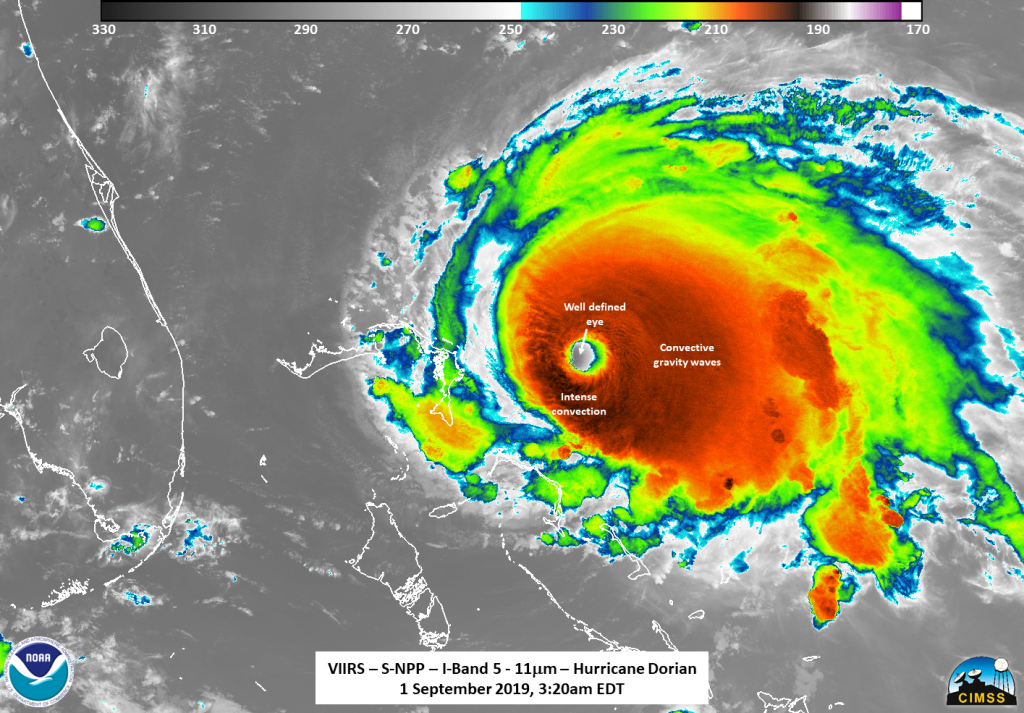
NASA and NOAA satellites flew over the storm after the NHC’s 2:00 am EDT (0600Z) advisory each highlighting unique features within the storm. At 3:20 am EDT (0720 UTC) NASA’s Suomi NPP satellite caught Dorian (above) on the east side of the scan in the Day Night band but due to the angle did not yield as many features due to noise at the edge of the scan, however, the well-defined eye can still be seen along with the tropospheric convective gravity waves flowing away from the storm.
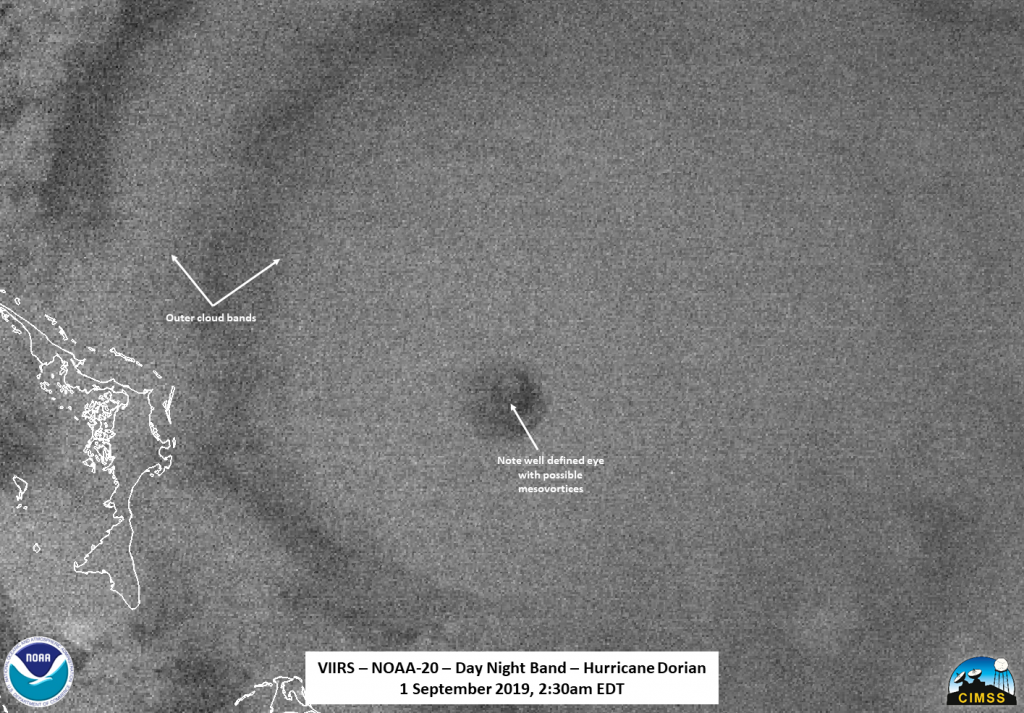
A slower westward motion should continue for the next day or two, followed by a gradual turn toward the northwest. On this track, the core of
extremely dangerous Hurricane Dorian will continue to pound Great Abaco today and the move near or over Grand Bahama Island tonight and Monday. The hurricane should move closer to the Florida east coast late Monday through Tuesday night.
Hurricane-force winds extend outward up to 45 miles (75 km) from the center and tropical-storm-force winds extend outward up to 140 miles (220 km). The eye of the hurricane is now 25 nautical miles across.

